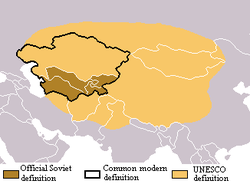Central Asia
Central Asia is a region in Asia. The countries in Cental Asia according to the United Nations are Kazakhstan, Kyrgyzstan, Uzbekistan, Turkmenistan, and Tajikistan.[1]
History
People have lived in the region of Central Asia since prehistoric times. Most of the region was part of the Silk Road. It was a part of the Persian Empire until Alexander The Great captured it. When he died, the land was given to his general Seleucus. Seleucus slowly lost it to the Parthians. When the Parthians (the Parthians were Persians) lost power, the Sassanids added it to their own Persian empire. However, a couple years later, during about the 600's A.D, Arab armies spreading the faith of Islam quickly captured it. A while later, an Iranian dynasty got semi- autonomy under the Abbasid Caliphate of Baghdad. They were known as the Samanids. The Samanids controlled most of Central Asia and Northwestern Iran. They had power over this area during the 10th century. With them, Central Asian cities, such as Bukhara and Samarkand, grew in culture.
In the early 13th century the Mongols captured it. They burned it to the ground. A while later, some rulers decided to make their own empires under that of the Mongols. These empires were known as Khanates. During the 19th century the Russian Empire conquered these lands. Many years later in 1991, all of the countries of Central Asia declared independence.
In the 14th century, Turkic armies conquered this area. They were known as the Seljuk Turks. At the same time, Timur captured it. After his death, the Timurids (the name of the people of the dynasty Timur founded) could not hold unto their empire.
Economy
Uzbekistan produces lots of cotton. Kazakhstan is rich because it has sold oil, gas and metals to Europe and China. Turkmenistan has adjusted better to independence from the Soviet Union than the other Central Asian countries, but it has been run by a autocratic form of government. Other than Kazakhstan, most of Central Asia are underdeveloped.
Central Asia Media
Expanded definition of Central Asia. Core definition that includes the five post-Soviet states in dark green. Afghanistan, the most commonly added country to Central Asia, in green. Regions that are sometimes considered part of Central Asia in light green.
On the south shore of Issyk Kul lake, Issyk Kul Region
The Eurasian Steppe in Kazakhstan has a semi-arid, continental climate
2071–2100 Central Asia map under the worst climate change scenario. Mid-range scenarios are currently considered more likely
Early Indo-European migrations from the Pontic steppes and across Central Asia. The Andronovo culture existed in Central Asia in the 2nd millennium BC.
Various Iranic speaking populations in Central Asia during the Iron Age (highlighted in green)
The Mongol Empire at its greatest extent. The gray area is the later Timurid Empire.
Uzbek men from Khiva, c. 1861–1880
Related pages
- Afghanistan
- Pakistan
- Kazakhstan
- Kyrgyzstan
- Tajikistan
- Tatarstan
- Turkmenistan
- Uzbekistan
- East Turkestan (Technically part of China)
- General Map of Central Asia: I from 1874
References
- ↑ "Central Asia | History, Geography & Culture | Britannica". www.britannica.com. 2025-04-09. Retrieved 2025-04-13.










